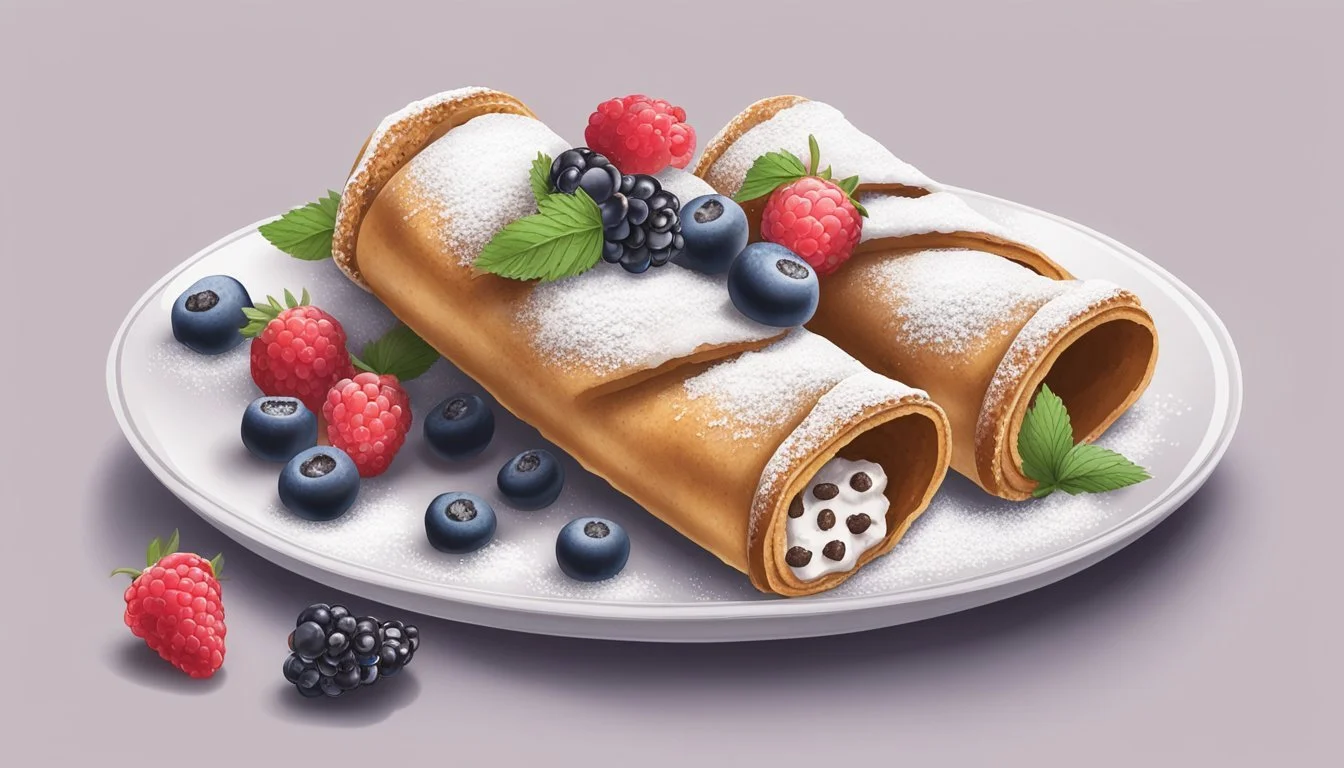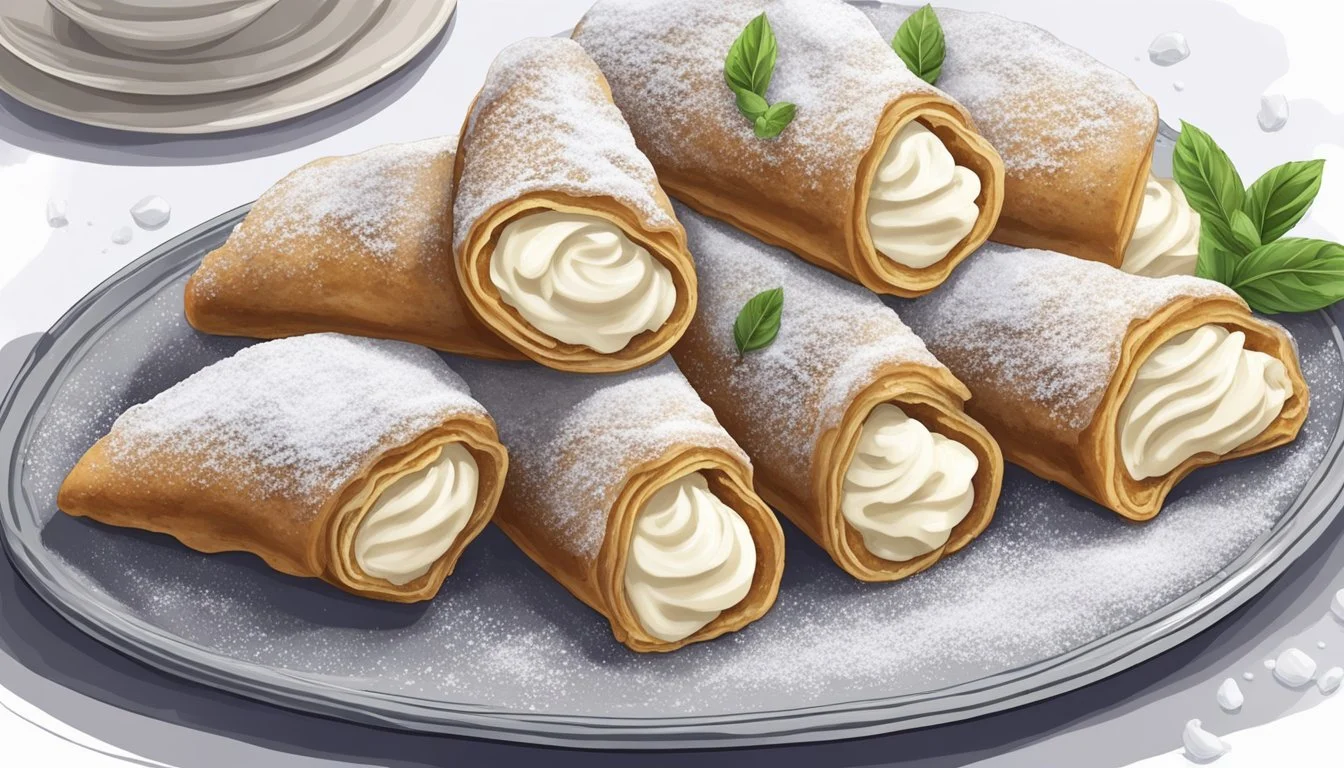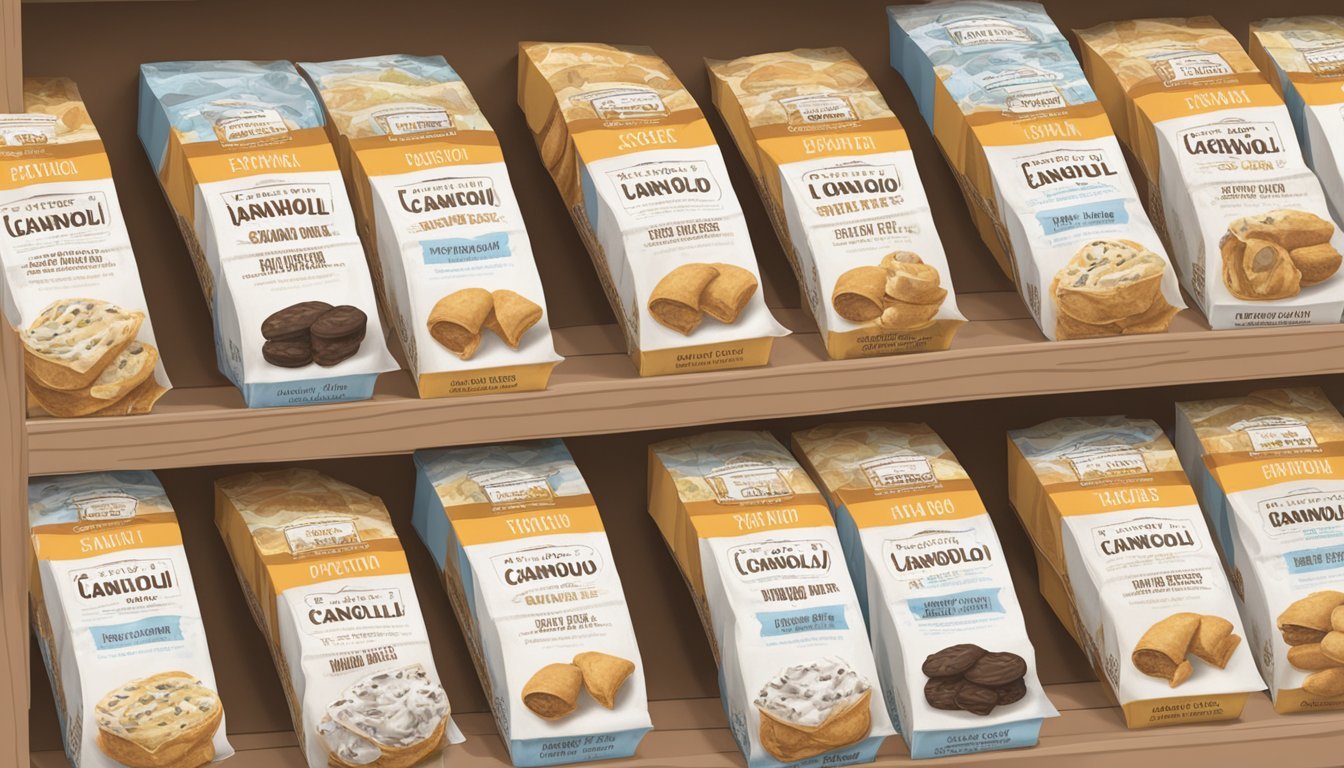Are Cannoli Vegan?
Uncovering the Truth About This Classic Dessert
Cannoli, a staple Italian pastry known for its crispy shell and creamy filling, traditionally features ingredients like ricotta cheese, eggs, and sometimes even lard, which are not aligned with a vegan diet. Given the rising demand for plant-based alternatives, vegan cannoli have emerged in the culinary scene, allowing those who avoid animal products to indulge in this classic dessert. Vegan cannoli swap out the dairy and egg-based ingredients for plant-based substitutes, such as vegan butter, dairy-free ricotta made from nuts or soy, and egg replacers.
The process of making vegan cannoli involves preparing a dough for the shells, typically with a mixture of flour, sugar, a binding agent—often in the form of plant-based milk or aquafaba—and a fat source like vegan butter or oil. This dough is then rolled out thinly, wrapped around cannoli forms, and either baked or fried to achieve the signature crunch.
The fillings for vegan cannoli take a creative twist, using ingredients like soaked cashews, almond milk, and tofu to create a consistency and flavor profile similar to traditional ricotta cream. Sweeteners such as sugar, agave, or maple syrup are added, along with flavorings like vanilla or citrus zest, to enhance the taste. Vegan cannoli have become a testament to the versatility of plant-based cooking, showing that with thoughtful ingredient substitution, even the most dairy-centric desserts (What wine goes well with desserts?) can be reimagined to suit a vegan lifestyle.
Understanding Veganism
Veganism is a lifestyle choice that abstains from the use of animal products, particularly in diet, favoring plant-based alternatives. This extends to all facets of life, but is most commonly associated with food choices.
Principles of a Vegan Diet
A vegan diet revolves around the consumption of plant-derived foods, avoiding all animal products and by-products. It's a diet that encompasses whole grains, fruits, vegetables, legumes, nuts, and seeds. Vegan cannoli, for example, would substitute traditional dairy-based ricotta with a dairy-free alternative and use eggless dough. The principles advocate for nutritionally complete meals, but also ethical eating practices that do not cause harm to animals.
Common Ingredients to Avoid
When adhering to a vegan diet, one must carefully scrutinize labels to avoid the following animal-derived ingredients:
Dairy: Found in the traditional filling of cannoli, it's replaced with alternatives such as almond, soy, or coconut milk products in vegan cannoli.
Eggs: Often used in baking and in pasta or pastry dough, plant-based binders like flax or chia seeds mixed with water can be used instead.
Ingredients to Avoid Vegan Alternatives Milk Almond, soy, coconut milk Ricotta Cheese Dairy-free cheese spreads Eggs Flax or chia "eggs"
These swaps ensure that individuals can enjoy similar textures and flavors to traditional dishes, like cannoli, while adhering to the vegan dietary principles.
Origins and Traditions of Cannoli
Cannoli, an Italian dessert composed of a fried pastry shell and a sweet ricotta filling, have a rich history and distinct regional variations in Sicily.
The History of Cannoli
The cannoli originated in Sicily with a history that is both extensive and culturally significant. The dessert's ancestry traces back to the Arabic influence during their rule in Sicily, where the culinary tradition of sweetened dairy began to take shape. The modern version of cannoli evolved as a symbol of fertility and was traditionally prepared during the carnival season, which is the period before Lent in the Christian calendar.
Key period: Carnival season
Symbolism: Fertility
Primary region of origin: Sicily
Cannoli Siciliani
Local Sicilian variations of the cannolo, which is the singular form of cannoli, emphasize the dessert's regional character. In different parts of Sicily, one can find adaptations in size, ingredients, and presentation of this iconic treat.
Sicilian Variations
Size: Ranges from small 'cannulicchi' to large cylindrical desserts
Ingredients: May include sweetened whipped ricotta, candied citrus peel (traditionally citron), and chocolate
The ricotta-based filling, itself a cornerstone of the dessert, shows the importance of dairy in Italian sweets, with the island's local cheeses contributing to the unique taste of cannoli. These elements together—pastry, ricotta, and iconic garnishes like pistachios or candied citrus—combine to form a dessert that is both deeply traditional and widely beloved.
Veganizing Cannoli
Vegan cannoli adapt the classic Italian dessert to fit a dairy-free and egg-free diet without compromising on texture or taste. The following subsections explore the essential ingredients needed for preparing vegan cannoli and the necessary substitutions for traditional non-vegan components.
Key Ingredients for Vegan Cannoli
Key ingredients for vegan cannoli shells typically include:
All-purpose flour or almond flour for a gluten-free alternative
A sweetener like granulated sugar
Cacao powder and cinnamon for flavoring
Vegan butter or oil to create a flaky texture
A liquid component such as a non-alcoholic wine or water for binding
For the filling:
Vegan ricotta or vegan cream cheese serves as the base
Sweeteners like powdered sugar
Flavor enhancers such as lemon juice or cinnamon
Vegan Substitutions for Traditional Ingredients
Traditional cannoli recipes require dairy-based ricotta and sometimes eggs for the shell mixture. Vegan recipes substitute these with the following:
Traditional Ingredient Vegan Substitution Ricotta Cheese Vegan Ricotta, made from either tofu or almonds Butter Vegan Butter or Margarine Eggs (in shell dough) Binding agents like water or dairy-free yogurt
Vegan ricotta can be homemade using blended tofu or almonds, mixed with nutritional yeast, salt, and lemon juice for tanginess. For creating the shells, vegan butter or margarine is worked into the dry ingredients to mimic the texture of traditional pastry. Instead of eggs, which are typically used to help bind the dough in non-vegan recipes, vegan cannoli shells may rely on substitutes like water, non-alcoholic wine, or dairy-free yogurt to achieve the correct consistency.
Preparing Vegan Cannoli
The craft of making vegan cannoli involves two primary components: preparing a pliable, flavorful dough for the shells and crafting a creamy, dairy-free ricotta filling to complete the dessert.
Making the Cannoli Dough
The dough for vegan cannoli shells typically entails a mixture of all-purpose flour, sugar, and a pinch of salt. The addition of vegan butter is crucial, as it replaces traditional lard or butter, ensuring the dough remains dairy-free. The butter should be cut into the dry ingredients until the mixture resembles coarse breadcrumbs. Wet ingredients might include water, lemon juice, or vinegar, which should be added sparingly to form a dough ball. Once the dough is smooth and elastic, it needs to rest to allow the gluten to relax, before rolling out and shaping into shells.
Ingredients for dough:
All-purpose flour
Granulated sugar
Salt
Vegan butter
Water
Lemon juice or vinegar (optional)
Instructions:
Combine flour, sugar, and salt in a bowl.
Work in vegan butter until the mixture is crumbly.
Add water, and lemon juice or vinegar if desired.
Knead until a smooth dough forms.
Allow to rest, then roll out for shaping.
Creating the Vegan Ricotta Filling
To mimic the rich and slightly sweet filling of a traditional cannoli, vegan ricotta can be made using cream cheese alternatives derived from almonds, cashews, or soy. Key to creating a convincing vegan ricotta texture is the blending process, which should incorporate sugar and flavorings until smooth. If additional tang is needed, a touch of lemon juice can enhance the filling. This mixture is then chilled to firm up before being piped into the crisp, golden shells that have been cooked either by baking or frying in vegetable oil.
Ingredients for filling:
Vegan cream cheese
Sugar (to taste)
Lemon juice (optional)
Instructions:
Blend vegan cream cheese and sugar until smooth.
Adjust sweetness and tanginess with sugar and lemon juice respectively.
Chill the filling to achieve a firmer consistency for piping.
The prep time for vegan cannoli will vary depending on whether the shells are fried or baked, but it usually takes a significant amount of time to prepare both components. The actual cook time for the shells can range from a couple of minutes when fried to around half an hour if baked. The total time from start to finish typically lands somewhere between 1 to 2 hours, including chilling the filling and dough resting periods.
Equipment and Techniques
Making vegan cannoli requires specific equipment to replicate the traditional method while ensuring the end product is plant-based. Accuracy and technique are critical in the creation of vegan cannoli shells and filling.
Essential Tools for Cannoli Making
Cannoli Tubes/Form: One must use cannoli tubes or forms, typically made of stainless steel or aluminum, to mold the dough into the classic tubular shape.
Piping Bag: A piping bag is essential for neatly filling the cannoli shells with vegan ricotta or an alternative plant-based filling.
Deep Fryer: Cannoli shells are traditionally fried to achieve their crispy texture. While not always necessary, a deep fryer can provide consistent heat and better results.
Equipment List:
Cannoli tubes or forms
Piping bag (with tips)
Deep fryer or a heavy pot
Dough Rolling and Shaping Methods
Rolling Pin: A rolling pin is crucial to roll out the dough to an even thickness before shaping it around the cannoli forms.
Pastry Cutter: A pastry cutter is often used to cut the rolled-out dough into circles before wrapping it around the tubes.
Pasta Machine: Some bakers prefer a pasta machine to roll the dough to the desired thickness consistently.
Food Processor: While not required, a food processor can assist in quickly mixing the dough ingredients. It should be powerful enough to handle a stiff dough.
Shaping Technique:
Roll dough to an even thickness.
Cut into circles or ovals.
Wrap around prepared cannoli tubes or forms.
For those who prefer modern appliances, a pasta machine ensures uniformity in dough thickness, and a food processor can expedite the mixing of dough ingredients, albeit neither is strictly necessary. The key is to roll the dough thin enough to wrap around the cannoli forms but thick enough to maintain structure when fried or baked.
Decorating and Serving Vegan Cannoli
The final presentation of vegan cannoli hinges on thoughtful decoration and appropriate serving methods to enhance both their aesthetic appeal and taste. A dusting of confectioners' sugar and a scattering of toppings can transform these treats into visual and gustatory delights.
Finishing Touches for Presentation
Once filled, vegan cannoli achieve a professional touch with a light sprinkling of powdered sugar, promptly applied to ensure a fresh, snowy appearance. For added texture and color, chocolate chips and chopped pistachios contribute contrasting elements that complement the creamy filling. A careful placement of these toppings on the open ends adds visual appeal and a hint of what lies within. Additionally, incorporating a subtle hint of orange zest or a drizzle of maple syrup over the top can impart a nuanced flavor profile and an enticing sheen.
Serving Suggestions for Vegan Cannoli
When serving, consider the setting and accompaniments. For a casual gathering, placing the cannoli on a platter alongside a selection of fruit can invite guests to partake as they please. In a more formal setting, individual dessert plates with an artful arrangement of a single cannoli, a drizzle of vanilla extract-infused maple syrup, and a few whole pistachios offer an elegant presentation. It's recommended to fill the cannoli shells immediately before serving to maintain their characteristic crunch. For a final flourish, a light dusting of confectioners' sugar can serve as both a decorative and flavor-enhancing touch just before these delectable sweets are enjoyed.
Storing and Shelf Life
When considering the storage and shelf life of vegan cannolis, it's essential to focus on maintaining the dessert's integrity. Both the crispness of the shell and the freshness of the filling are key to the cannoli's quality.
Best Practices for Storage
To ensure vegan cannolis retain their texture, each component should be stored separately until ready to serve. Shells should be kept at room temperature in an airtight container, isolated from moisture, which could lead to sogginess. On the other hand, fillings containing ingredients like vegan ricotta should be refrigerated.
Shells:
Store in an airtight container.
Keep at room temperature away from moisture.
Filling:
Refrigerate promptly to maintain freshness.
Use within one to two weeks, when possible, to minimize the risk of spoilage.
Maximizing Freshness and Flavor
The filling's delicacy makes it more perishable due to its moisture content and potential for bacterial growth. To maximize freshness and flavor, the filling should be consumed within a short period after preparation. In the fridge, the filling can be stored safely for one to two weeks, ideally in an airtight container.
Avoiding Saturated Fat Spoilage:
Vegan fillings often contain alternative fats that can become rancid; refrigeration helps prevent spoilage of these fats.
Freezing Shells:
Freeze for no longer than a few weeks to keep the shells crisp.
Use a rigid container to protect against crushing.
By adhering to these guidelines, vegan cannolis can stay as delightful as on the day they were made.
Nutritional Information
When assessing the nutritional content of vegan cannoli, it's essential to look at the calorie and fat content, as well as compare it to traditional cannoli. These parameters help understand the health profile of this dessert option.
Calorie and Fat Content
Vegan cannoli largely consist of all-purpose flour, sugar, and a fat component often derived from vegan butter or oil. A typical vegan cannoli shell, paired with a ricotta-style filling made from almond or soy milk, can contain around 150 to 200 calories per serving. The fat content is influenced by the type of vegan butter or oil used, averaging between 2.5 to 10 grams of fat, with lower levels of saturated fat compared to traditional cannoli due to the absence of dairy products.
Comparing Vegan and Traditional Cannoli
When juxtaposing vegan cannoli with their traditional counterparts, several differences in nutritional content arise. Traditional cannoli, filled with dairy-based ricotta cheese, tend to have a higher content of saturated fat and overall caloric density.
Component Vegan Cannoli Traditional Cannoli Calories Around 150-200 per serving Typically higher than vegan cannoli Fat 2.5-10g, with lower saturated fat Higher fat, including saturated fat Saturated Fat Lower, due to no dairy ingredients Higher, due to dairy-based ricotta Sugar May vary depending on the recipe Usually present in similar quantities Alternative Milks Often use soy or almond milk Dairy milk is used
It is clear that vegan cannoli offer a dessert option with potentially lower levels of saturated fats and calories, which might be advantageous for those looking to enjoy a sweet treat while adhering to a vegan lifestyle or managing their intake of these nutritional components.
Recipe Variations and Enhancements
Crafting a delectable vegan cannoli requires creativity and willingness to explore different flavors and ideas. This section provides specific variations and innovative takes on traditional cannoli that cater to the vegan diet while maintaining the dessert's iconic delight.
Flavor Variations for Vegan Cannoli
Classic Chocolate and Cinnamon: Add a twist to vegan cannoli by incorporating cocoa powder and a hint of cinnamon into the shell batter. For a richer flavor, one could introduce vegan dark chocolate chips into the filling.
Citrus Zest: Incorporating lemon or orange zest into the cannoli cream can imbue a fresh and tangy flavor profile, which contrasts beautifully with the sweet, creamy filling.
Coffee Infusion: Coffee lovers may infuse the cannoli cream with espresso or finely ground coffee for an invigorating mocha kick.
Seasonal Spices: Depending on the season, adding spices like nutmeg, cloves, or pumpkin pie spice to the filling can align the cannoli with festive flavors.
Innovative Vegan Cannoli Ideas
Brandy Snap Cannoli Shells: Replace traditional shells with a vegan brandy snap mixture to offer a unique, crisp texture with a subtle brandy flavor.
Savory Spin: Who says cannoli must always be sweet? Exploring savory fillings, such as a vegan ricotta and spinach blend, can transform cannoli into a satisfying appetizer.
Dairy-Free Chocolate Drizzle: For a visually appealing and flavor-enhancing touch, drizzle melted dairy-free chocolate over the assembled cannoli just before serving.
Substitution of Marsala Wine: Marsala wine is a common ingredient in cannoli recipes; however, one can substitute it with a combination of apple juice and a splash of balsamic vinegar to achieve a similar depth of flavor.
Experimenting with these enhancements can lead to a variety of delicious vegan cannoli that honor the essence of the Italian dessert while adhering to plant-based principles.
Pairing with Beverages
When selecting beverages to accompany vegan cannoli, one should consider flavors that enhance the sweet and creamy attributes of the dessert without overpowering it. The choices range from sweet dessert wines to refreshing non-alcoholic options.
Dessert Wines and Vegan Cannoli
Dessert wines can elevate the experience of enjoying vegan cannoli. Moscato, with its fruity notes and sweet profile, harmonizes with the cannoli's sweetness while adding a layer of complexity with its natural peach, apricot, and orange blossom aromas. Similarly, Marsala wine, traditionally used in non-vegan cannoli recipes, can be a splendid complement due to its rich flavor, which aligns well with the creamy filling.
Recommended Pairings:
Moscato: Enhances the dessert’s sweetness with fruity undertones.
Marsala Wine: Brings forth a bold yet suitable match for the pronounced flavors of vegan cannoli.
Non-Alcoholic Pairings for Cannoli
Those who prefer non-alcoholic beverages have delightful options as well. The key is to choose a drink that is subtle yet refreshing. Chilled water serves as a neutral palate cleanser between bites. On the other hand, non-alcoholic iterations of white wine, like a NA Chardonnay, mimic the complexity of their alcoholic counterparts and can add a sophisticated twist to the pairing.
Suggested Non-Alcoholic Beverages:
Chilled Water: A simple, refreshing option to cleanse the palate.
Non-Alcoholic White Wine: Offers a complex pairing without the alcohol content.
Concluding Thoughts
The exploration of vegan cannoli reveals that these Italian delicacies can indeed embrace plant-based innovation. Traditional cannoli, known as cannoli siciliani, are not vegan since they contain dairy products. Vegan pastry chefs have reimagined the classic treat with dairy-free substitutes like coconut milk to maintain the creamy texture of the filling.
The Future of Vegan Desserts
The trajectory of vegan desserts is marked by creativity and an increasing commitment to replicating traditional favorites with plant-based ingredients. Vegan cannoli exemplify how dairy-free alternatives, such as coconut milk, are being employed to achieve the desired richness and flavor. This trend signals a promising future where vegan options are not only available but are comparable in taste and texture to their non-vegan counterparts.











